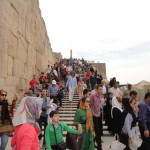 Pasargad Heritage Foundation (PHF) was established a decade ago outside Iran with the aim of preserving Iranian cultural heritage. For the last nine years, on the advent of each Iranian New Year (which coincides with the beginning of spring), PHF designates a name for the coming new year that signifies certain aspects of its mission. The main purpose of this “name designation” is to emphasize the priceless value of the ancient cultural heritage of Iran that are exposed to constant destruction due to intentional and accidental negligence of the relevant authorities n Iran.
Pasargad Heritage Foundation (PHF) was established a decade ago outside Iran with the aim of preserving Iranian cultural heritage. For the last nine years, on the advent of each Iranian New Year (which coincides with the beginning of spring), PHF designates a name for the coming new year that signifies certain aspects of its mission. The main purpose of this “name designation” is to emphasize the priceless value of the ancient cultural heritage of Iran that are exposed to constant destruction due to intentional and accidental negligence of the relevant authorities n Iran.
This year PHF has named the New Year of the Iranian calendar as the “Year of Omar Khayyam”. Khayyam has been an internationally known Iranian poet (known by his famous Rubaiyat or Quatrains), philosopher, mathematician and an astronomer. In addition to being known for his poetry or Rubaiyat, he also created one of the three major world solar calendars, based on the ancient Iranian chronometry which was also accepted as a major accurate calendar globally.
Unfortunately, due to his non-religious opinions and his scientific outlook, Omar Khayyam has not been popular with the religious authorities of his country. During the last seven years, Iranian authorities have forbidden teaching about his work, personality and as a result account of life story has been changed.
Naming the New Iranian year, the “Year of Omar Khayyam” would hopefully bring more recognition and awareness of his contributions not only to Iranian Cultural Heritage a country he was from but also to the human civilization.


























